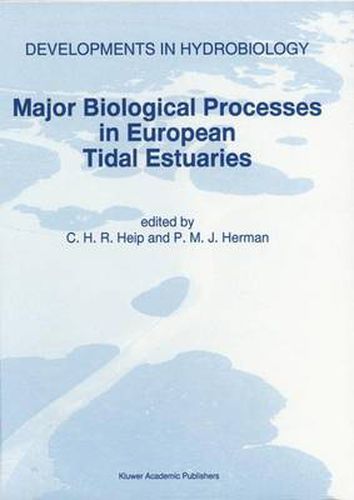Readings Newsletter
Become a Readings Member to make your shopping experience even easier.
Sign in or sign up for free!
You’re not far away from qualifying for FREE standard shipping within Australia
You’ve qualified for FREE standard shipping within Australia
The cart is loading…






Table 1. State variables modeled in MOSES. State variable Units Estuaries are characterized by a strong diversity in car- bon sources. This is because of the existence of an 3 Fast-decay detritus g- intertidal habitat, the supply of nutrients and organic 3 Slow-decay detritus g- material from the river and from the sea and the input of 3 gCm- Freshwater diatoms matter from human origin. If turbidity remains limited, 3 Freshwater flagellates g- estuaries can also support a high primary production 3 Brackish and marine diatoms g- as nutrients are abundant. Nevertheless, estuaries are 3 Cm- Brackish and marine flagellates usually heterotrophic ecosystems (Billen et aI. , 1991; 3 gCm- Micro-zooplankton Smith & Hollibaugh, 1993) where respiratory process- 3 Brackish meso-zooplankton gCm- 3 es exceed in situ production. Marine meso-zooplankton gCm- 2 3 gCm- The Westerschelde estuary (260 km in SAWES, Hyperbenthos 3 gSim- Detrital silicate 1991) drains about 21580 square kilometres ofland in 3 gSim- Dissolved silicate one of the most densely populated and highly industri- 3 gNm- Nitrate and nitrite alised regions of Europe (Wollast, 1988). This estuary 3 gNm- Ammonia is unusual due to the high degree of eutrophication 3 gOm- Oxygen which results from the discharge of untreated wastes 3 gCl m- Chlorides (Heip, 1988) and due to the high residence time of the 3 gm- Suspended matter water masses (Soetaert & Herman, 1995a).
$9.00 standard shipping within Australia
FREE standard shipping within Australia for orders over $100.00
Express & International shipping calculated at checkout
Table 1. State variables modeled in MOSES. State variable Units Estuaries are characterized by a strong diversity in car- bon sources. This is because of the existence of an 3 Fast-decay detritus g- intertidal habitat, the supply of nutrients and organic 3 Slow-decay detritus g- material from the river and from the sea and the input of 3 gCm- Freshwater diatoms matter from human origin. If turbidity remains limited, 3 Freshwater flagellates g- estuaries can also support a high primary production 3 Brackish and marine diatoms g- as nutrients are abundant. Nevertheless, estuaries are 3 Cm- Brackish and marine flagellates usually heterotrophic ecosystems (Billen et aI. , 1991; 3 gCm- Micro-zooplankton Smith & Hollibaugh, 1993) where respiratory process- 3 Brackish meso-zooplankton gCm- 3 es exceed in situ production. Marine meso-zooplankton gCm- 2 3 gCm- The Westerschelde estuary (260 km in SAWES, Hyperbenthos 3 gSim- Detrital silicate 1991) drains about 21580 square kilometres ofland in 3 gSim- Dissolved silicate one of the most densely populated and highly industri- 3 gNm- Nitrate and nitrite alised regions of Europe (Wollast, 1988). This estuary 3 gNm- Ammonia is unusual due to the high degree of eutrophication 3 gOm- Oxygen which results from the discharge of untreated wastes 3 gCl m- Chlorides (Heip, 1988) and due to the high residence time of the 3 gm- Suspended matter water masses (Soetaert & Herman, 1995a).